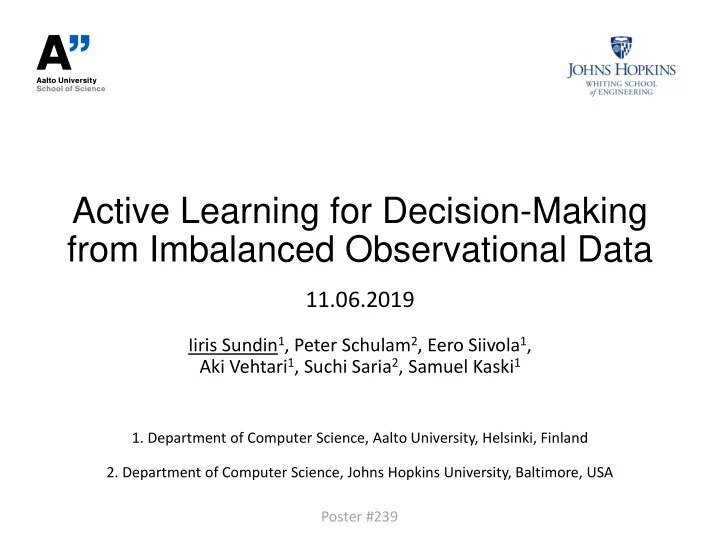

Active Learning for Decision-Making from Imbalanced Observational Data 11.06.2019 Iiris Sundin 1 , Peter Schulam 2 , Eero Siivola 1 , Aki Vehtari 1 , Suchi Saria 2 , Samuel Kaski 1 1. Department of Computer Science, Aalto University, Helsinki, Finland 2. Department of Computer Science, Johns Hopkins University, Baltimore, USA Poster #239
Problem and setup • Decision-making task: Choose treatment to a new, previously unseen unit 𝑦 • Learn individual treatment effect 𝜐 = 𝔽[𝑧 1 − 𝑧 0 ∣ 𝑦] Treated • Imbalance Control (=not treated) • Different covariate distributions in treated and control groups 𝑞(𝜐 ∣ 𝑦, 𝐸) • Causes uncertainty to Ƹ 𝑦 11.6.2019 Poster #239 2
Decision-making performance • Type S error rate • Probability that the model infers the sign of the treatment effect wrong True treatment effects Effect Estimated treatment effects correct decision wrong decision 0 Type S error 11.6.2019 Poster #239 3
Contributions • Conditions when imbalance increases Type S error rate • Estimate for Type S error rate • Active learning to minimize estimated Type S error rate Semi-synthetic medical data * Decision-making aware (this work) Expected targeted information gain Expected information gain Uncertainty sampling * Infant Health and Development Program (IHDP) data (Hill 2011). 11.6.2019 Poster #239 4
Summary • Imbalance impairs decision-making performance • Type S error rate • A natural measure for decision-making performance • Bayesian estimate of Type S error rate • Active learning that targets the Type S error rate the most effective in improving decisions • Code available at https://github.com/IirisSundin/active-learning-for-decision-making Poster #239 Twitter: @iirisSun
Recommend
More recommend